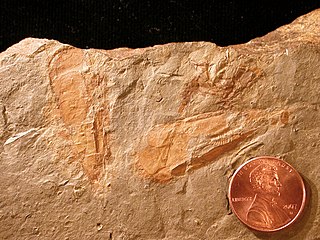
Hyoliths are animals with small conical shells, known from fossils from the Palaeozoic era. They are at least considered as being lophotrochozoan, and possibly being lophophorates, a group which includes the brachiopods, while others consider them as being basal lophotrochozoans, or even molluscs.
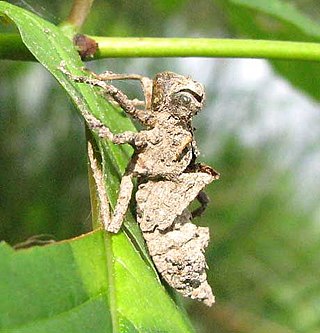
An exoskeleton is a skeleton that is on the exterior of an animal in the form of hardened integument, which both supports the body's shape and protects the internal organs, in contrast to an internal endoskeleton which is enclosed underneath other soft tissues. Some large, hard and non-flexible protective exoskeletons are known as shell or armour.

Kimberella is an extinct genus of bilaterian known only from rocks of the Ediacaran period. The slug-like organism fed by scratching the microbial surface on which it dwelt in a manner similar to the gastropods, although its affinity with this group is contentious.
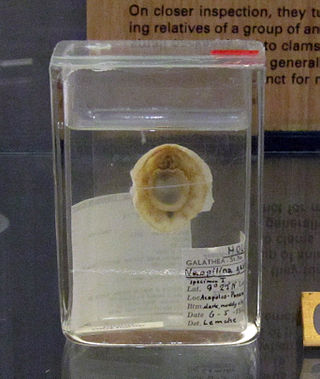
Monoplacophora, meaning "bearing one plate", is a polyphyletic superclass of molluscs with a cap-like shell, inhabiting deep sea environments. Extant representatives were not recognized as such until 1952; previously they were known only from the fossil record, and were thought to have become extinct 375 million years ago.
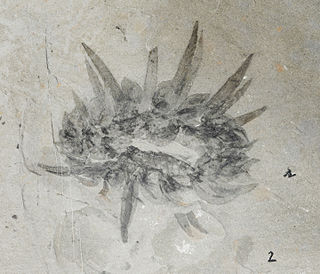
Wiwaxia is a genus of soft-bodied animals that were covered in carbonaceous scales and spines that protected it from predators. Wiwaxia fossils—mainly isolated scales, but sometimes complete, articulated fossils—are known from early Cambrian and middle Cambrian fossil deposits across the globe. The living animal would have measured up to 5 centimetres (2 in) when fully grown, although a range of juvenile specimens are known, the smallest being 2 millimetres (0.08 in) long.
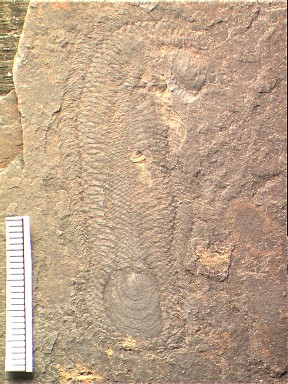
The halkieriids are a group of fossil organisms from the Lower to Middle Cambrian. Their eponymous genus is Halkieria, which has been found on almost every continent in Lower to Mid Cambrian deposits, forming a large component of the small shelly fossil assemblages. The best known species is Halkieria evangelista, from the North Greenland Sirius Passet Lagerstätte, in which complete specimens were collected on an expedition in 1989. The fossils were described by Simon Conway Morris and John Peel in a short paper in 1990 in the journal Nature. Later a more thorough description was undertaken in 1995 in the journal Philosophical Transactions of the Royal Society of London and wider evolutionary implications were posed.
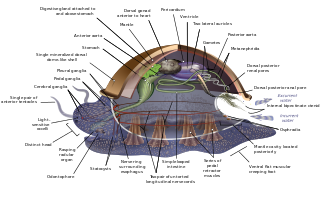
The evolution of the molluscs is the way in which the Mollusca, one of the largest groups of invertebrate animals, evolved. This phylum includes gastropods, bivalves, scaphopods, cephalopods, and several other groups. The fossil record of mollusks is relatively complete, and they are well represented in most fossil-bearing marine strata. Very early organisms which have dubiously been compared to molluscs include Kimberella and Odontogriphus.

Odontogriphus is a genus of soft-bodied animals known from middle Cambrian Lagerstätte. Reaching as much as 12.5 centimetres (4.9 in) in length, Odontogriphus is a flat, oval bilaterian which apparently had a single muscular foot and a "shell" on its back that was moderately rigid but of a material unsuited to fossilization.
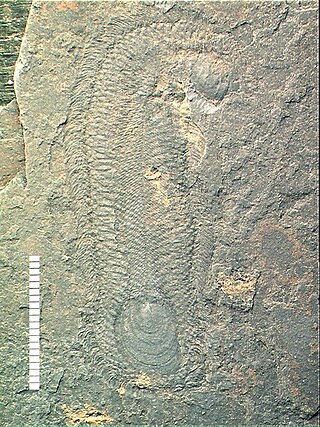
Halwaxiida or halwaxiids is a proposed clade equivalent to the older orders Sachitida He 1980 and Thambetolepidea Jell 1981, loosely uniting scale-bearing Cambrian animals, which may lie in the stem group to molluscs or lophotrochozoa. Some palaeontologists question the validity of the Halwaxiida clade.

Marine invertebrates are the invertebrates that live in marine habitats. Invertebrate is a blanket term that includes all animals apart from the vertebrate members of the chordate phylum. Invertebrates lack a vertebral column, and some have evolved a shell or a hard exoskeleton. As on land and in the air, marine invertebrates have a large variety of body plans, and have been categorised into over 30 phyla. They make up most of the macroscopic life in the oceans.

Scenella is an extinct genus of fossil invertebrate animal which is generally considered to be a mollusc; at various times it has been suggested that this genus belongs with the gastropods, the monoplacophorans, or the helcionellids, although no firm association with any of these classes has been established. An affinity with the hydrozoa has been considered, although some authors oppose this hypothesis. A gastropod affinity is defended on the basis of six pairs of internal muscle scars, whilst the serially-repeated nature of these scars suggests to other authors a monoplacophoran affinity. However the specimens showing this scarring have not been convincingly shown to belong to the genus Scenella. A similarity to the Ediacaran Ovatoscutum has also been drawn.

The "Cambrian substrate revolution" or "Agronomic revolution", evidenced in trace fossils, is a sudden diversification of animal burrowing during the early Cambrian period.

Helcionellid or Helcionelliformes is an order of small fossil shells that are universally interpreted as molluscs, though no sources spell out why this taxonomic interpretation is preferred. These animals are first found about 540 to 530 million years ago in the late Nemakit-Daldynian age, which is the earliest part of the Cambrian period. A single species persisted to the Early Ordovician. These fossils are component of the small shelly fossils (SSF) assemblages.
The small shelly fauna, small shelly fossils (SSF), or early skeletal fossils (ESF) are mineralized fossils, many only a few millimetres long, with a nearly continuous record from the latest stages of the Ediacaran to the end of the Early Cambrian Period. They are very diverse, and there is no formal definition of "small shelly fauna" or "small shelly fossils". Almost all are from earlier rocks than more familiar fossils such as trilobites. Since most SSFs were preserved by being covered quickly with phosphate and this method of preservation is mainly limited to the late Ediacaran and early Cambrian periods, the animals that made them may actually have arisen earlier and persisted after this time span.
The Cambrian explosion is an interval of time approximately 538.8 million years ago in the Cambrian period of the early Paleozoic when a sudden radiation of complex life occurred, and practically all major animal phyla started appearing in the fossil record. It lasted for about 13 to 25 million years and resulted in the divergence of most modern metazoan phyla. The event was accompanied by major diversification in other groups of organisms as well.

Mollusca is the second-largest phylum of invertebrate animals, after Arthropoda; members are known as molluscs or mollusks. Around 76,000 extant species of molluscs are recognized. The number of fossil species is estimated between 60,000 and 100,000 additional species. The proportion of undescribed species is very high. Many taxa remain poorly studied.
The Kirengellids are a group of problematic Cambrian fossil shells of marine organisms. The shells bear a number of paired muscle scars on the inner surface of the valve.
The cephalopods have a long geological history, with the first nautiloids found in late Cambrian strata.
Stage 2 of the Cambrian is the unnamed upper stage of the Terreneuvian Series. It lies atop the Fortunian and below Stage 3 of the Cambrian. It is commonly referred to as the Tommotian, after the Cambrian stratigraphy of Siberia. Neither the upper nor lower boundary has yet been defined by the International Commission on Stratigraphy. The preferred definitions for the lower boundary are the first appearance of the molluscs Watsonella crosbyi or Aldanella attleborensis around 529 million years ago. The correlation between the lowest occurrences of A. attleborensis and W. crosbyi with the Zhujiaqing positive carbon isotope excursion (ZHUCE) has led to the conclusion that the combination of these two markers are a reliable indicator of the boundary between the Fortunian and Stage 2. The proposed upper boundary might be the first appearance of trilobites around 521 million years ago.
Cambrian Stage 3 is the still unnamed third stage of the Cambrian. It succeeds Cambrian Stage 2 and precedes Cambrian Stage 4, although neither its base nor top have been formally defined. The plan is for its lower boundary to correspond approximately to the first appearance of trilobites, about 521 million years ago, though the globally asynchronous appearance of trilobites warrants the use of a separate, globally synchronous marker to define the base. The upper boundary and beginning of Cambrian Stage 4 is informally defined as the first appearance of the trilobite genera Olenellus or Redlichia around 514 million years ago.












